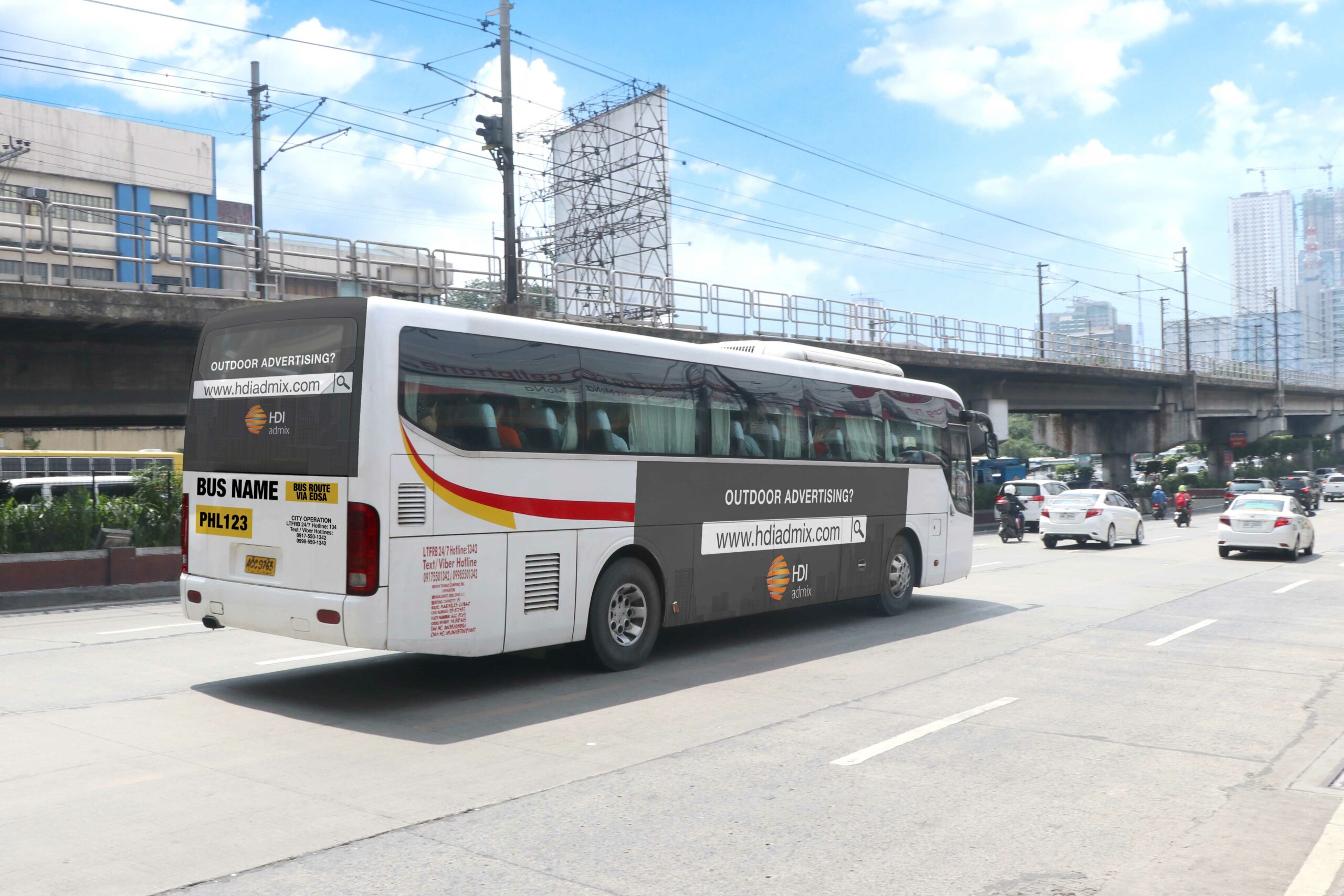Transit Advertising Philippines for Unmatched Brand Visibility
Transit Advertising Philippines for Unmatched Brand Visibility
Blog Article
Recognizing the Duty of Transportation Marketing in Enhancing Brand Visibility and Customer Engagement
Transportation advertising and marketing has arised as a critical component in the advertising landscape, offering special chances for brand names to raise their visibility and involve consumers properly. With the capability to reach a varied and captive target market during their everyday commutes, these advertising approaches are not simply about presence; they are about creating significant connections with possible customers. As we discover the complex advantages and ingenious methods within transportation advertising and marketing, it ends up being crucial to think about just how these elements collectively affect customer perception and habits, questioning about their long-term impact on brand loyalty.
Interpretation of Transportation Marketing
Transit advertising describes the method of promoting products, solutions, or brand names with ads placed in and around mass transit systems. This kind of advertising and marketing incorporates a selection of placements, consisting of posters on trains and buses, digital screens at transportation stations, and wraps on the outside of automobiles. It aims to get to a varied audience, taking advantage of the high foot website traffic connected with public transit.
Transportation marketing is purposefully positioned to capture the focus of commuters, that commonly invest considerable time waiting or taking a trip. By incorporating advertisements right into the daily regimens of people, brands can develop a long lasting impact and foster brand acknowledgment. The medium is especially effective in urban settings, where mass transit is a primary setting of travel.
Additionally, transportation marketing can assist in local targeting, permitting companies to reach particular demographics based on transit paths and station locations. As urban populations grow and using public transport increases, this advertising and marketing method has gained prominence as a vital part of incorporated marketing techniques. The vibrant nature of transit advertising, integrated with its capability to involve customers in a restricted atmosphere, highlights its value in modern advertising and marketing practices.
Benefits of Transit Advertising
The efficiency of transit advertising and marketing depends on its ability to supply a wide range of advantages to brand names looking for to boost exposure and involvement. Among the primary benefits is the comprehensive reach it supplies; transit advertisements can properly target diverse demographics across urban locations, getting to both travelers and pedestrians alike. This wide exposure dramatically improves brand name understanding.
An additional benefit is the high frequency of impacts. As transportation lorries take a trip along well established paths and stop at numerous places, they create repetitive direct exposure that strengthens brand messages. This frequency cultivates experience, which is vital in customer decision-making.
Transit advertising is likewise cost-efficient contrasted to various other media systems. Provided its extensive reach and potential for high impressions, brands typically experience a lower cost per thousand perceptions (CPM), optimizing their advertising and marketing budget.
Furthermore, transit ads can develop a sense of community link. By lining up with regional transit systems, brand names can resonate with local audiences and foster a feeling of local satisfaction. This local method boosts brand commitment and interaction, making transportation marketing an engaging choice for services intending to solidify their existence on the market.

Effective Techniques for Transit Campaigns
To optimize the effect of transit campaigns, brand names need to utilize critical preparation and implementation tailored to their target audience. Initially, recognizing the market attributes of the audience using public transportation is crucial. This permits brand names to produce customized messaging that resonates with possible consumers.
Following, choosing the right transit tools is necessary. Whether making use of bus covers, train posters, or digital screens, each medium has distinct advantages that can enhance presence. For example, lively visuals on bus wraps can bring in interest, while electronic advertisements can be updated regularly to show timely promos.
Furthermore, integrating a cohesive branding approach across transit systems makes sure consistency and strengthens the brand name's identity. Making use of remarkable taglines and captivating layouts will certainly strengthen brand name recall among commuters.
By using these strategies, brand names can properly harness the potential of transit marketing, cultivating better awareness and connection with their target audience. Eventually, a well-executed transportation project can drive substantial growth in brand exposure and customer involvement.

Measuring Impact and Interaction
In assessing the efficiency of transit advertising projects, precise measurement of influence and interaction is essential for brand names seeking to maximize their advertising and marketing techniques. Metrics such as reach, regularity, and perceptions give foundational information to evaluate presence. Examining these factors assists establish the amount of prospective consumers are exposed to the promotions during their everyday commutes.
Involvement can be further assessed through consumer communications, such as site web traffic, social networks mentions, and straight responses to calls-to-action included in the ads. Making use of tools like Home Page QR codes or unique URLs can promote tracking of consumer habits directly linked to transportation campaigns. Surveys and comments systems also offer as important methods to collect qualitative data on customer perceptions and recall of the ad.
Moreover, advanced analytics and acknowledgment designs can associate transportation direct exposure with subsequent acquiring habits, supplying understandings right into the roi. By employing a comprehensive method that combines qualitative and measurable actions, brand names can create a nuanced understanding of their transportation marketing effect. Eventually, this data-driven method allows brands to fine-tune their campaigns, ensuring they resonate efficiently with target audiences and enhance general brand presence.
Instance Researches of Effective Campaigns
Successful transportation marketing campaign function as compelling examples of exactly how reliable techniques can elevate web link brand visibility and interaction. Transit Advertising Philippines. One remarkable case is the "I Love New York" campaign, which changed the city's image and brought in numerous tourists. By making use of metro advertisements, signboards, and bus wraps, the campaign developed a solid, cohesive brand identification, resulting in a considerable uptick in tourist and regional business patronage
One more excellent campaign is Coca-Cola's "Share a Coke" campaign, which leveraged transit advertising to customize the brand name experience. By featuring popular names on advertising materials throughout various transit systems, Coca-Cola fostered a much deeper psychological connection with customers, encouraging them to share their experiences on social networks.
In addition, the "Got Milk?" campaign properly utilized mass transit ads to get to a wide audience, strengthening the message of the relevance of milk in a balanced diet plan. The project saw a quantifiable increase in milk usage in target demographics.
These study show that when executed thoughtfully, transportation advertising and marketing can considerably improve brand name visibility, foster consumer involvement, and drive quantifiable outcomes, showing its essential role in modern advertising strategies. - Transit Advertising Philippines
Conclusion
In verdict, transit advertising offers as an essential device for improving brand name exposure and fostering customer involvement. Eventually, the ability to measure engagement and assess successful instance research studies underscores the performance of transit advertising and marketing in driving brand commitment and consumer communications.
Transit advertising and marketing has arised as an essential element in the advertising and marketing landscape, offering one-of-a-kind opportunities for brand names to raise their visibility and involve consumers properly.In addition, transit advertising can facilitate local targeting, enabling businesses to get to certain demographics based on transit courses and station areas.In examining the performance of transit advertising projects, precise dimension of effect and interaction is vital for brands looking for see here to enhance their advertising and marketing techniques.Effective transit advertising and marketing campaigns serve as engaging instances of just how efficient approaches can boost brand presence and engagement.In conclusion, transportation advertising serves as an important device for improving brand visibility and fostering consumer engagement.
Report this page